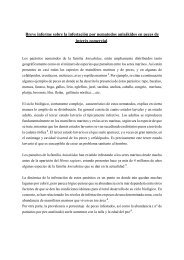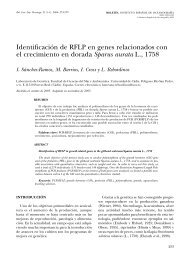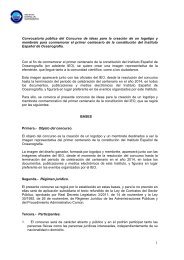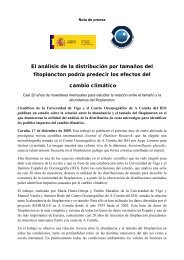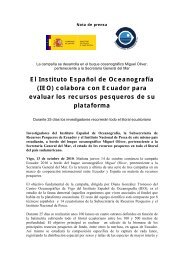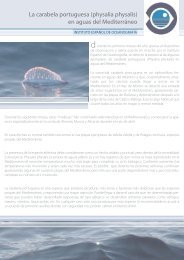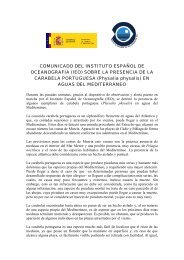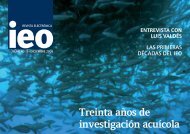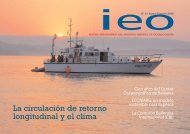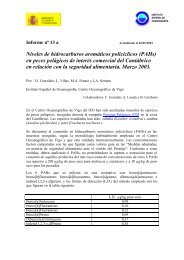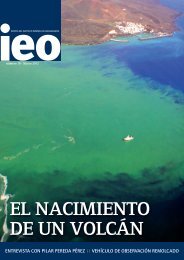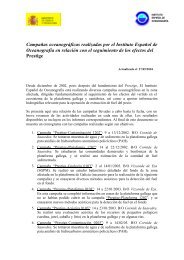Production of the ragworm Nereis diversicolor - El Instituto Español ...
Production of the ragworm Nereis diversicolor - El Instituto Español ...
Production of the ragworm Nereis diversicolor - El Instituto Español ...
You also want an ePaper? Increase the reach of your titles
YUMPU automatically turns print PDFs into web optimized ePapers that Google loves.
Bol. Inst. Esp. Oceanogr. 19 (1-4). 2003: 447-451 BOLETÍN. INSTITUTO ESPAÑOL DE OCEANOGRAFÍA<br />
ISSN: 0074-0195<br />
© <strong>Instituto</strong> <strong>Español</strong> de Oceanografía, 2003<br />
<strong>Production</strong> <strong>of</strong> <strong>the</strong> <strong>ragworm</strong> <strong>Nereis</strong> <strong>diversicolor</strong><br />
(O. F. Müller, 1776), fed with a diet for gil<strong>the</strong>ad<br />
seabream Sparus auratus L., 1758: survival, growth,<br />
feed utilization and oogenesis<br />
F. M. Batista 1 , P. Fidalgo e Costa 2,3 , A. Ramos 1 , A. M. Passos 2 , P. Pousão<br />
Ferreira 1 and L. Cancela da Fonseca 1,2<br />
1 Ipimar/Cripsul, Av. 5 de Outubro, P-8700-305 Olhão, Portugal. E-mail: fmbatista@yahoo.com<br />
2 Imar/Laboratório Marítimo da Guia, Faculdade de Ciências de Universidade de Lisboa, Estrada do Guincho,<br />
P-2750-374 Cascais, Portugal<br />
3 Escola Superior de Educaçaõ João de Deus, Av. Álvares Cabral, 69, P-1269-094 Lisboa, Portugal<br />
Received January 2003. Accepted December 2003.<br />
ABSTRACT<br />
A 65-day experiment was conducted to determine survival, growth, feed utilization and oogenesis<br />
<strong>of</strong> <strong>Nereis</strong> <strong>diversicolor</strong> (O. F. Müller, 1776), fed with a commercial dry diet developed for gil<strong>the</strong>ad<br />
seabream Sparus auratus L., 1758. Worms were reared in three replicate tanks with 50 worms<br />
per tank (255 indiv · m �2). Tetramin ®, a commonly used diet for ornamental fish and polychaete<br />
laboratory experiments, was used as a control.<br />
Survival was high (� 95.3 %) for both treatments, and not significantly affected by diet.<br />
Specific growth rates and feed efficiency ratios did not differ significantly between worms fed with<br />
ei<strong>the</strong>r diets, nor were <strong>the</strong>re significant differences in <strong>the</strong> proportion <strong>of</strong> individuals in <strong>the</strong> oocyte<br />
size classes.<br />
Keywords: <strong>Nereis</strong> <strong>diversicolor</strong>, Sparus auratus, polyculture, growth, oogenesis.<br />
RESUMEN<br />
Producción del poliqueto <strong>Nereis</strong> <strong>diversicolor</strong> (O. F. Müller, 1776) alimentado con dieta de dorada<br />
Sparus auratus L., 1758: supervivencia, crecimiento, utilización del alimento y oogénesis<br />
La supervivencia, el crecimiento, la utilización del alimento y la oogénesis de <strong>Nereis</strong> <strong>diversicolor</strong> (O. F.<br />
Müller, 1776) alimentado con pienso de dorada Sparus auratus L., 1758 fueron estudiados durante 65<br />
días. Los poliquetos se cultivaron en tres tanques replicados con 50 individuos en cada uno (255 indiv · m �2).<br />
Como control se utilizó Tetramin ®, una dieta común para peces ornamentales y en experimentos de laboratorio<br />
con poliquetos.<br />
La supervivencia fue alta (� 95,3 %) en ambos tratamientos y no se vio afectada significativamente por<br />
la dieta. <strong>El</strong> aumento de peso y los cocientes de eficiencia alimentaria no variaron significativamente entre los<br />
poliquetos alimentados con ambas dietas. Entre los grupos experimentales no hubo diferencia significativa en<br />
la proporción de individuos por clases de tamaño de los oocitos.<br />
Palabras clave: <strong>Nereis</strong> <strong>diversicolor</strong>, Sparus auratus, policultivo, crecimiento, oogénesis.<br />
447
F. M. Batista et al. <strong>Production</strong> <strong>of</strong> <strong>Nereis</strong> <strong>diversicolor</strong> fed with gil<strong>the</strong>ad seabream diet<br />
INTRODUCTION<br />
The culture <strong>of</strong> <strong>the</strong> gil<strong>the</strong>ad sea bream Sparus auratus<br />
L. 1758 is a growing industry in Portugal and<br />
Spain. Farming is mostly carried out in ear<strong>the</strong>n<br />
ponds in semi-extensive and intensive systems based<br />
on <strong>the</strong> consumption <strong>of</strong> specific commercial dry<br />
feeds. As in most monoculture systems, undesirable<br />
wastes are produced, with uneaten feed and <strong>the</strong> faeces<br />
produced by <strong>the</strong> fishes constituting a considerable<br />
part <strong>of</strong> <strong>the</strong> organic fraction <strong>of</strong> <strong>the</strong>se effluents.<br />
The integration <strong>of</strong> organisms into different positions<br />
<strong>of</strong> <strong>the</strong> food chain in polyculture systems can<br />
be used to reduce <strong>the</strong> environmental impact <strong>of</strong><br />
aquaculture effluents (Brzeski and Newkirk, 1997).<br />
The polychaete <strong>Nereis</strong> <strong>diversicolor</strong> (O. F. Müller,<br />
1776), seems to be a good candidate for this integration,<br />
since: 1) this species can obtain nourishment<br />
as a carnivore, herbivore, suspensivore, or detritivore<br />
(Bradshaw et al., 1990; Nielsen et al., 1995;<br />
Riisgård, 1991); 2) it has a high tolerance to variations<br />
in environmental conditions such as temperature,<br />
salinity, and oxygen content (Kristensen,<br />
1983; Ozoh and Jones, 1990); 3) it plays a major<br />
role in organic matter decomposition and nutrient<br />
cycling processes in sediments (Banta et al., 1999;<br />
Heilskov and Holmer, 2001); and 4) it is commonly<br />
found inside or in <strong>the</strong> immediate vicinity <strong>of</strong> fish<br />
farms, in higher densities near automatic feeders<br />
(Pocklington, Scott and Schafer, 1994; Pousão-<br />
Ferreira, Machado and Cancela da Fonseca, 1995).<br />
The reproductive behaviour <strong>of</strong> N. <strong>diversicolor</strong> can also<br />
be seen as an advantage, since this species<br />
spawns in <strong>the</strong> atokous form (Dales, 1950; Bartels-<br />
Hardege and Zeeck, 1990), making it possible to<br />
establish a population in restricted areas.<br />
Fur<strong>the</strong>rmore, this species, like o<strong>the</strong>r polychaetes<br />
belonging to <strong>the</strong> Nereidae family, has a high economic<br />
value due to its use as bait for sport and pr<strong>of</strong>essional<br />
fishing; moreover, a new market is being<br />
discovered in <strong>the</strong> aquaculture industry, that <strong>of</strong> food<br />
for finfish and crustacean broodstocks (Dinis,<br />
1986; Gambi et al., 1994; Olive, 1999).<br />
The present work is part <strong>of</strong> a broader study which<br />
aims to elucidate <strong>the</strong> feasibility <strong>of</strong> an integrated<br />
polyculture system featuring S. auratus and N. <strong>diversicolor</strong>.<br />
The objective <strong>of</strong> this study was to evaluate <strong>the</strong><br />
survival, growth, feed utilization and oogenesis <strong>of</strong> N.<br />
<strong>diversicolor</strong> fed with a commercial S. auratus diet, in<br />
order to test whe<strong>the</strong>r this species can use <strong>the</strong> uneaten<br />
feed <strong>of</strong> S. auratus as a food source.<br />
448<br />
MATERIALS AND METHODS<br />
Hatchery-reared juvenile N. <strong>diversicolor</strong> from <strong>the</strong><br />
Tavira Shellfish Hatchery Station <strong>of</strong> <strong>the</strong> Portuguese<br />
Institute for Fisheries and Sea Research (Ipimar)<br />
were randomly selected from culture tanks and sequentially<br />
stocked into <strong>the</strong> experimental units. A<br />
subsample <strong>of</strong> 40 individuals was randomly collected<br />
and used for measuring initial weight (7.8 � 0.7 mg<br />
mean wet weight � SE). Initial and final weights <strong>of</strong><br />
worms were determined after 24 h <strong>of</strong> starvation to<br />
empty <strong>the</strong> gut and 2 min. drainage on absorbent<br />
paper. The animals were reared for a period <strong>of</strong> 65<br />
days, and each treatment was run in three replicate<br />
tanks with 50 worms per tank (255 indiv. m �2).<br />
The rearing system consisted <strong>of</strong> a series <strong>of</strong> tanks<br />
(0.196 m 2) with constant aeration. Medium sand<br />
(250-500 µm) was dried in an oven at 90 ºC for 24<br />
h to kill any organisms present. The sand was<br />
placed in <strong>the</strong> tanks to a depth <strong>of</strong> 4 cm. Worms were<br />
reared under natural photoperiod (January to<br />
March in 2001; 37º 07’ N, 7º 38’ W) at ambient temperature,<br />
with a mean � SD (range) maximum<br />
temperature <strong>of</strong> 16,6 � 2,2 ºC (22-13) and minimum<br />
temperature <strong>of</strong> 13,8 � 1,9 ºC (11-18). Salinity<br />
was maintained at 36 in both treatments, representing<br />
<strong>the</strong> main conditions <strong>of</strong> <strong>the</strong> S. auratus production<br />
areas in <strong>the</strong> south <strong>of</strong> Portugal and Spain.<br />
Worms were fed with two different types <strong>of</strong> feed<br />
every o<strong>the</strong>r day to apparent satiation, which resulted<br />
in very similar amounts <strong>of</strong> feed distributed for<br />
both treatments. The amount <strong>of</strong> food given was<br />
recorded. The diets were a low-cost S. auratus dry<br />
feed (56 % crude protein) and Tetramin ® dry feed,<br />
developed for ornamental fish (46 % crude protein).<br />
The latter last diet was used as a control,<br />
since it is commonly employed successfully in polychaete<br />
laboratory experiments (Garwood and<br />
Olive, 1981; Fidalgo e Costa, Narciso and Cancela<br />
da Fonseca, 2000).<br />
At <strong>the</strong> end <strong>of</strong> <strong>the</strong> experiment, all animals from<br />
each tank were counted, and <strong>the</strong> individual wet<br />
weight determined. The specific growth rate (SGR):<br />
% d �1 � 100 [ln (final wet weight) � ln (initial<br />
wet weight)]/duration,<br />
and <strong>the</strong> feed efficiency ratio (FER):<br />
(final wet weight � initial wet weight)/dry food<br />
consumed<br />
were calculated.<br />
A sample <strong>of</strong> 10 individuals per tank was randomly<br />
removed for sexual differentiation. The sexual<br />
Bol. Inst. Esp. Oceanogr. 19 (1-4). 2003: 447-451
F. M. Batista et al. <strong>Production</strong> <strong>of</strong> <strong>Nereis</strong> <strong>diversicolor</strong> fed with gil<strong>the</strong>ad seabream diet<br />
maturity <strong>of</strong> <strong>the</strong> females present in each sample was<br />
quantified by taking samples <strong>of</strong> <strong>the</strong> coelomic fluid<br />
and measuring 30 oocytes per female.<br />
Data from <strong>the</strong> experiment, which had a completely<br />
randomised design with three replicates per<br />
treatment, was analysed with Student’s t-test to examine<br />
differences in survival, specific growth rate,<br />
and food efficiency ratio between treatments (Zar,<br />
1984).<br />
Treatments were replicated, but for analysis purposes,<br />
data concerning oocyte size were pooled.<br />
Individual females were assigned to 30 µm oocyte<br />
frequency categories according to <strong>the</strong> mean <strong>of</strong> <strong>the</strong><br />
oocyte diameter, and were <strong>the</strong>n compared statistically<br />
using a G-test procedure following <strong>the</strong> methodology<br />
used by Olive, Simon and Djunaedi (1998).<br />
Statistical significance was examined at P � 0.05.<br />
RESULTS<br />
Survival was high for both treatments and not<br />
significantly (P � 0.05) affected by <strong>the</strong> diets.<br />
Specific growth rate and food conversion ratio did<br />
not differ significantly (P � 0.05) between worms<br />
fed with <strong>the</strong> two diets (table I).<br />
Table I. Survival, specific growth rate and feed efficiency ratio<br />
<strong>of</strong> N. <strong>diversicolor</strong> fed with S. auratus dry feed (SBDF) and<br />
ornamental fish dry feed (OFDF) for 65 days. Data represent<br />
mean <strong>of</strong> three tanks (SE)<br />
Diets Survival (%) Specific growth Feed efficiency<br />
rate (% d�1) ratio<br />
OFDF 99.3 (0.7) 7.78 (0.03) 1.62 (0.04)<br />
SBDF 95.3 (1.3) 7.88 (0.17) 1.89 (0.14)<br />
Frequency (%)<br />
40<br />
30<br />
20<br />
10<br />
0<br />
SBDF<br />
0-50 51-100 101-150 151-200 201-250 251-300 > 301<br />
Weight (mg)<br />
Tank 2 Tank 3 Tank 4<br />
A high variability was observed between worms<br />
within replicate tanks in both feeding regimes (figure<br />
1).<br />
A G-test analysis found no significant differences<br />
in <strong>the</strong> proportion <strong>of</strong> individuals in <strong>the</strong> oocyte size<br />
classes between treatments (figure 2).<br />
DISCUSSION<br />
Due to <strong>the</strong> differences in experimental conditions,<br />
it is difficult to compare <strong>the</strong> results obtained<br />
in this study with those obtained in o<strong>the</strong>r studies<br />
carried out with N. <strong>diversicolor</strong>. One <strong>of</strong> main difficulties<br />
was <strong>the</strong> worm size, since most studies were carried<br />
out with larger individuals (Nielsen et al., 1995;<br />
Fidalgo e Costa, Narciso and Cancela da Fonseca,<br />
2000). In addition, <strong>the</strong>se experiments used individual<br />
or small groups <strong>of</strong> worms, making direct comparisons<br />
even more difficult. Never<strong>the</strong>less, <strong>the</strong> SGR<br />
obtained in <strong>the</strong> present study were higher than SGR<br />
<strong>of</strong> 6.8 % d �1 reported by Fidalgo e Costa, Narciso<br />
and Cancela da Fonseca (2000) for one-month-old<br />
N. <strong>diversicolor</strong> fed Tetramin ® with a density <strong>of</strong> 390 indiv.<br />
m �2. These differences can be explained by <strong>the</strong><br />
lower density used in <strong>the</strong> present study (255 indiv.<br />
m �2), which is in agreement with results obtained<br />
by Bridges et al. (1996) in <strong>Nereis</strong> arenaceodentata: <strong>the</strong>y<br />
reported a decrease in growth when density was<br />
high. On <strong>the</strong> o<strong>the</strong>r hand, a higher variability between<br />
replicate tanks was observed in <strong>the</strong> SGR and<br />
FER <strong>of</strong> worms reared on S. auratus dry feed<br />
(SBDF), in comparison with <strong>the</strong> control diet. This<br />
variability can be explained by <strong>the</strong> different homogeneity<br />
<strong>of</strong> <strong>the</strong> two feed pellets, since <strong>the</strong> Tetramin ®<br />
OFDF<br />
0-50 51-100 101-150 151-200 201-250 251-300 > 301<br />
Weight (mg)<br />
Tank 1 Tank 5 Tank 6<br />
Figure 1. Frequency distribution <strong>of</strong> N. <strong>diversicolor</strong> from replicate tanks, fed with S. auratus dry feed (SBDF) and ornamental<br />
fish dry food (OFDF) for 65 days<br />
Bol. Inst. Esp. Oceanogr. 19 (1-4). 2003: 447-451 449
F. M. Batista et al. <strong>Production</strong> <strong>of</strong> <strong>Nereis</strong> <strong>diversicolor</strong> fed with gil<strong>the</strong>ad seabream diet<br />
No. individuals<br />
pellets were much more heterogeneous and numerous<br />
than <strong>the</strong> SBDF pellets, allowing worms <strong>of</strong><br />
different sizes to ingest pellets <strong>of</strong> adequate size, thus<br />
reducing competition for food. Given that no differences<br />
were found in SGR and FER between<br />
worms fed with <strong>the</strong> two diets, <strong>the</strong> results <strong>of</strong> <strong>the</strong> present<br />
study suggested that <strong>the</strong> tested SBDF can support<br />
good growth rates.<br />
A high variability was observed in <strong>the</strong> present<br />
study between worms within tanks fed with both diets.<br />
These results are in agreement with o<strong>the</strong>r observations<br />
by Fidalgo e Costa (1999) for N. <strong>diversicolor</strong>.<br />
In addition, unpublished data collected by<br />
<strong>the</strong> present authors when juvenile N. <strong>diversicolor</strong><br />
were individually reared under similar conditions<br />
(23.6 mg individual wet weight; n � 22) during 27<br />
days showed a high variability in specific growth<br />
rates (4.0-6.9 % d �1, with coefficient <strong>of</strong> variation <strong>of</strong><br />
14.4 %). These findings suggest that <strong>the</strong> heterogeneous<br />
growth observed between worms within<br />
tanks in <strong>the</strong> present study may have been caused by<br />
genetic differences, promoting size-dependent<br />
dominance and subsequent feeding hierarchies.<br />
The advanced stage <strong>of</strong> maturation <strong>of</strong> some females<br />
observed in <strong>the</strong> present study, and <strong>the</strong> fact<br />
that larvae were observed in both treatments approximately<br />
one month after <strong>the</strong> end <strong>of</strong> <strong>the</strong> experiment,<br />
supports <strong>the</strong> idea that precocious maturation<br />
in some polychaetes can be achieved by<br />
optimization <strong>of</strong> <strong>the</strong> feeding rate (Grémare, Marsh<br />
and Tenore, 1988; Fidalgo e Costa, unpublished).<br />
The results <strong>of</strong> <strong>the</strong> present study indicate that <strong>the</strong><br />
polychaete N. <strong>diversicolor</strong> is able to flourish and re-<br />
450<br />
6<br />
4<br />
2<br />
0<br />
31-60 61-90 91-120 121-150 151-180 181-210<br />
Mean oocyte diameter (µm)<br />
SBDF OFDF<br />
Figure 2. Distribution frequency for individual females N.<br />
<strong>diversicolor</strong> fed with gil<strong>the</strong>ad S. auratus dry feed (SBDF) and<br />
with ornamental fish dry food (OFDF) classified into 30 µm<br />
groups by mean oocyte diameter<br />
produce using <strong>the</strong> tested SBDF as a food source,<br />
confirming <strong>the</strong> species’s good prospects for polyculture<br />
with S. auratus (Pousão-Ferreira, Machado<br />
and Cancela da Fonseca, 1995).<br />
ACKNOWLEDGEMENTS<br />
The authors would like to thank Dr Raquel<br />
Carmona for translating <strong>the</strong> abstract into Spanish.<br />
REFERENCES<br />
Banta, G. T., M. Holmer, M. H. Jensen and E. Kristensen.<br />
1999. Effects <strong>of</strong> two polychate worms, <strong>Nereis</strong> <strong>diversicolor</strong><br />
and Arenicola marina, on aerobic and anaerobic decomposition<br />
in a sandy marine sediment. Aquatic Microbial<br />
Ecology 19: 189-204.<br />
Bartels-Hardege, H. D. and E. Zeeck. 1990. Reproductive<br />
behaviour <strong>of</strong> <strong>Nereis</strong> <strong>diversicolor</strong> (Annelida: Polychaeta).<br />
Marine Biology 106: 409-412.<br />
Bradshaw, S. A., S. C. M. O’Hara, E. D. S. Corner and G.<br />
Eglinton. 1990. Dietary lipid changes during herbivory<br />
and coprophagy by <strong>the</strong> marine invertebrate <strong>Nereis</strong> <strong>diversicolor</strong>.<br />
Journal <strong>of</strong> <strong>the</strong> Marine Biology Association (UK) 70:<br />
771-787.<br />
Bridges, T. S., D. Farrar, E. V. Gamble and T. M. Dillon.<br />
1996. Intraspecific density effects in <strong>Nereis</strong> (Nean<strong>the</strong>s) arenaceodentata<br />
Moore (Polychaeta: Nereidae). Journal <strong>of</strong><br />
Experimental Marine Biology and Ecology 195: 221-235.<br />
Brzeski, V. and G. Newkirk. 1997. Integrated coastal food<br />
production systems – a review <strong>of</strong> current literature.<br />
Ocean & Coastal Management 34: 55-71.<br />
Dales, R. P. 1950. The reproduction and larval development<br />
<strong>of</strong> <strong>Nereis</strong> <strong>diversicolor</strong> O. F. Müller. Journal <strong>of</strong> <strong>the</strong> Marine<br />
Biology Association (UK) 24: 321-360.<br />
Dinis, M. T. 1986. Quatre soleidae de l‘estuaire du Tage.<br />
Reproduction et croissance. Essai d’elevage de Solea senegalensis<br />
Kaup. Ph.D. <strong>the</strong>sis. University <strong>of</strong> Bretagne Occidentale:<br />
348 pp.<br />
Fidalgo e Costa, P. 1999. Reproduction and growth in captivity<br />
<strong>of</strong> <strong>the</strong> polychaete <strong>Nereis</strong> <strong>diversicolor</strong> O. F. Müller,<br />
1776, using two different kinds <strong>of</strong> sediment: Preliminary<br />
assays. Boletín. <strong>Instituto</strong> <strong>Español</strong> de Oceanografía 15 (1-4):<br />
351-355.<br />
Fidalgo e Costa, P., L. Narciso and L. Cancela da Fonseca.<br />
2000. Growth, survival and fatty acid pr<strong>of</strong>ile <strong>of</strong> <strong>Nereis</strong> <strong>diversicolor</strong><br />
(O. F. Müller, 1776) fed on six different diets.<br />
Bulletin <strong>of</strong> Marine Science 67 (1): 337-343.<br />
Gambi, M. C., A. Castelli, A. Giangrande, P. Lanera, D.<br />
Prevedelli and R. Z. Vandini. 1994. Polychaetes <strong>of</strong> commercial<br />
and applied interest in Italy: an overview. In:<br />
Actes de la 4éme Conférence Internationale des polychètes. J. C.<br />
Dauvin, L. Laubier and D. J. Reish (eds.) 162: 593-603.<br />
Memoires du Muséum National d’ Historie Naturelle.<br />
Paris.<br />
Bol. Inst. Esp. Oceanogr. 19 (1-4). 2003: 447-451
F. M. Batista et al. <strong>Production</strong> <strong>of</strong> <strong>Nereis</strong> <strong>diversicolor</strong> fed with gil<strong>the</strong>ad seabream diet<br />
Garwood, P. R. and P. J. W. Olive. 1981. The influence <strong>of</strong> environmental<br />
factors on <strong>the</strong> growth <strong>of</strong> oocytes <strong>of</strong> <strong>Nereis</strong> <strong>diversicolor</strong><br />
(Annelida; Polychaete). Bulletin de la Société<br />
Zoologique de France 106 (4): 399-402.<br />
Grémare, A., A. G. Marsh and K. R. Tenore. 1988. Shortterm<br />
reproductive responses <strong>of</strong> Capitella sp. (Annelida:<br />
Polychaete) fed on different diets. Journal <strong>of</strong> Experimental<br />
Marine Biology and Ecology 123: 147-162.<br />
Heilskov A. C. and M. Holmer. 2001. Effects <strong>of</strong> benthic fauna<br />
on organic matter mineralization in fish-farm sediments:<br />
importance <strong>of</strong> size and abundance. ICES Journal<br />
<strong>of</strong> Marine Science 58: 427-434.<br />
Kristensen, E. 1983. Ventilation and oxygen uptake by three<br />
species <strong>of</strong> <strong>Nereis</strong> (Annelida: Polychaeta). I. Effects <strong>of</strong> hypoxia.<br />
Marine Ecology. Progress Series 12: 289-297.<br />
Nielsen, A. M., N. T. Eriksen, J. J. L. Iversen and H. U.<br />
Riisgård. 1995. Feeding, growth and respiration in <strong>the</strong><br />
polychaetes <strong>Nereis</strong> <strong>diversicolor</strong> (facultative filter-feeder)<br />
and N. virens (omniverous) – a comparative study. Marine<br />
Ecology. Progress Series 125: 149-158.<br />
Olive, P. J. W. 1999. Polychaete aquaculture and polychaete<br />
science: a mutual synergism. Hydrobiologia 402: 175-183.<br />
Olive, P. J. W., W. R. Simon and A. Djunaedi. 1998.<br />
Influence <strong>of</strong> photoperiod and temperature on oocyte<br />
growth in <strong>the</strong> semelparous polychaete <strong>Nereis</strong> (Nean<strong>the</strong>s)<br />
virens. Marine Ecology. Progress Series 172: 169-183.<br />
Ozoh, P. T. E. and N. V. Jones. 1990. Capacity adaptation <strong>of</strong><br />
Hediste (<strong>Nereis</strong>) <strong>diversicolor</strong> embryogenesis to salinity, temperature<br />
and copper. Marine Environmental Research 29:<br />
227-243.<br />
Pocklington, P., D. B. Scott and C. T. Schafer. 1994.<br />
Polychaete response to different aquaculture activities.<br />
In: Actes de la 4éme Conférence Internationale des polychètes. J.<br />
C. Dauvin, L. Laubier and D. J. Reish (eds.) 162: 511-520.<br />
Memoires du Muséum National d’ Historie Naturelle.<br />
Paris.<br />
Pousão-Ferreira, P., M. Machado and L. Cancela da<br />
Fonseca. 1995. Marine pond culture in sou<strong>the</strong>rn<br />
Portugal: present status and future perspectives. Cahiers<br />
Options Méditerranéennes 16: 21-30.<br />
Riisgård, H. U. 1991. Suspension feeding in <strong>the</strong> polychaete<br />
<strong>Nereis</strong> <strong>diversicolor</strong>. Marine Ecology. Progress Series 70: 29-37.<br />
Zar, J. H. 1984. Biostatistical Analysis. Prentice-Hall,<br />
Englewood Cliffs. New Jersey: 662 pp.<br />
Bol. Inst. Esp. Oceanogr. 19 (1-4). 2003: 447-451 451



